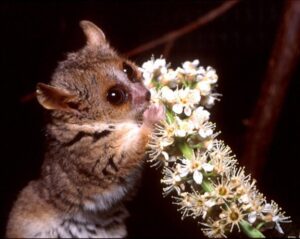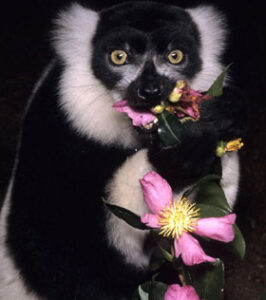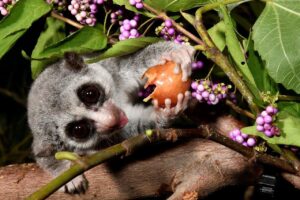Lemurs: Gardeners of the Forest
Lemurs and forests go way back. So far back that almost everything about lemurs—their locomotion, their diet, their physical appearance—has evolved as a result of a life in the trees. We think of lemurs as being dependent on the forests of Madagascar, and that is certainly true, but it is less often that we consider the dependence of the forests on the lemurs.

A mouse lemur investigates a selection of flowers.
With over one hundred lemur species living in a variety of forest ecosystems and eating an incredible diversity of plants, the impact that lemurs have on their ecosystem is enormous. The forests provide the lemurs with resources for survival, and in turn, the lemurs help the forest to flourish through pollination and seed dispersal.

A blue-eyed black lemur checks out the camera during an enrichment session with fresh spring flowers.
While lemur diets can differ greatly from one species to another, at least ten lemur species have nectar on the menu. Though nectar is a seasonal resource, it is the second-most important food source for several of those species, right under fruit or leaves. Nectar is a sugar-rich, easily digestible energy source for many animals, not just bees and butterflies. While lemurs may not have wings and a proboscis to aid them, they do have a set of adaptations that serve them just as well.

Black and white ruffed lemurs are important seed dispersers and pollinators in Madagascar.
Nectar-eating lemurs tend to have longer, narrower snouts and long tongues to reach inside flowers without destroying them. The ruffs of fur around the snouts and cheeks of these lemurs (most notably the ruffed lemurs, named after their fluffy neck ruffs) are what collect the pollen during feeding and transfer it effectively to other blossoms. While it takes energy for a tree to produce enough nectar to satisfy a lemur, the payoff is immediate. Flowering trees in Madagascar also have larger, brighter flowers with higher quantities of nectar and strong aromasto attract larger pollinators like lemurs, and tougher parts to withstand feeding by a larger animal. It is likely that lemurs and flowers experienced coevolution, both adapting to benefit the other.

A fat-tailed dwarf lemur munches on a berry. Despite their size, the play an important role in seed dispersal.
References:
Magdalena N. Muchlinski, Jonathan M. G. Perry, “Anatomical Correlates to Nectar Feeding among the Strepsirrhines of Madagascar: Implications for Interpreting the Fossil Record”, Anatomy Research International, vol. 2011, Article ID 378431, 17 pages, 2011.
Kress, W. (1993). Coevolution of plants and animals: Pollination of flowers by primates in Madagascar. Current Science, 65(3), 253-257. Retrieved April 12, 2021, from http://www.jstor.org/stable/24095125
OH Razafindratsima, E Razafimahatratra. Effect of red ruffed lemur gut passage on the germination of native rainforest plant species. Lemur News, 2010, 39-41.
Ramananjato, V, Rakotomalala, Z, Park, DS, et al. The role of nocturnal omnivorous lemurs as seed dispersers in Malagasy rain forests. Biotropica. 2020; 52: 758–765.

